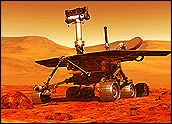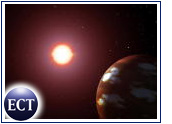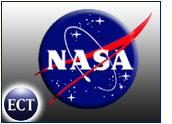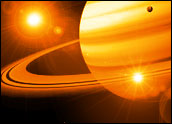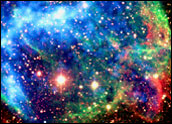
A team of astronomers has announced the discovery of some of the smallest planets yet detected beyond our solar system: two worlds that represent a new category of extra-solar planets. Each of newly discovered planets is roughly comparable to the planet Neptune in our own solar system, says Geoffrey Marcy of the University of California, Berkeley, a veteran planet-hunter and a codiscoverer of this pair.
That’s still pretty big on a terrestrial scale, he says. Neptune has 17 times the mass of the Earth. But it’s tiny compared to the 120-plus extra-solar planets that have been discovered to date. Virtually all of those objects are considerably heftier than our own solar system’s heavyweights, Jupiter and Saturn, which have 318 times and 95 times the mass of the Earth, respectively.
Harbingers of More Planets
In addition, says Marcy, these newly discovered Neptunes might well be the harbingers of many more (and smaller) things to come. Although lower-mass planets like these tend to be harder to detect than their higher-mass cousins, the statistics to date suggest they occur more frequently. And if that’s the case, he says, then an obvious extrapolation suggests that we might soon be seeing many more Neptunes — and that Earth-sized planets, if we can ever detect them, might be downright abundant.
The discovery team was supported jointly by the National Science Foundation (NSF) and the National Aeronautics and Space Administration (NASA). They publicly announced their findings at a NASA Science Update on August 31, 2004, and will publish their results this December as two separate, peer-reviewed papers in the Astrophysical Journal.
On August 25, European astronomers announced preliminary evidence for a third Neptune-sized extra-solar planet.
Two Neptunes
The first of the two new Neptunes was discovered by a team led by Paul Butler from the Carnegie Institution of Washington. The group was following a detection strategy that Marcy and Butler helped pioneer more than a decade ago, and that has accounted for the majority of exoplanet detections so far.
Instead of trying for an actual image — even the biggest exoplanet is much too faint and far away for that — they monitored a long list of candidate stars, looking for wobbles that might be caused by the gravitational tug of an orbiting planet. The wobbles would show up as subtle “Doppler shifts” in the starlight; by observing those shifts over a period of years, the astronomers could then infer the planet’s approximate mass, orbital size and period.
In this case, the astronomers used one of the twin Keck telescopes on Mauna Kea, Hawaii, to monitor 950 nearby stars, 150 of which were a type of cool, reddish, very low-mass star known as an “M dwarf.” The effort paid off in July 2003, when the astronomers noticed a periodic wobble in Gliese 436, an M dwarf star that lies about 33 light-years from Earth in the direction of the constellation of Leo.
Year of Data Acquisition
Another 12 months of data-taking confirmed the result: Gliese 436 has a Neptune-sized planet of at least 21 Earth masses that goes whipping around in its circular orbit once every 2.64 days. That corresponds to an orbital radius of roughly 4.5 million kilometers, or about 3 percent of Earth’s distance from the sun.
From our terrestrial perspective, this does make for a rather bizarre kind of solar system. Even Mercury, the closest planet to our sun, has an orbital period of 88 days and an orbital radius of 58 million kilometers-more than 12 times further out. And our own Neptune has an orbital period of 165 years and an orbital radius of 4.5 billion kilometers: a thousand times further out.
Still, for reasons that no one really understands, such close-in giant planets seem to be the rule among the solar systems discovered so far.

